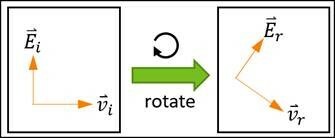When a ray passes a real lens, it's obvious we should just follow the Fresnel's equation to calculate the change to the polarization (electirc field). However, the Paraxial surface in sequential mode and Paraxial Lens object in non-sequential mode are ideal optical element. They only describe how the rays' direction is changed, but what happens to the polarization state.
[FAQ] What happens to the polarization when a ray passes Paraxial Lens
Best answer by Michael Cheng
When a ray passes Paraxial lens in either sequential mode or non-sequential mode. We always keep k*E = 0. We use different methods in sequential and non-sequential modes to keep k*E = 0.
In Sequential mode, you simply rotate the electric field based on the k vectors of the ray before and after the refraction.

On the other hand, in Non-sequential mode, when a ray is bent by a Paraxial lens, OpticStudio project the 'electric field before Paraxial Lens' to a plane that is orthogonal to the ray after passing the Paraxial Lens. The projected electric field is then scaled to have same amplitude as the electric field before the Paraxial lens.

Note neither the treatments in sequential nor non-sequential mode are perfect. The Paraxial lens is an ideal component and there is no 'correct' answer about how to handle polarization. We always keep k*E=0, which makes the total energy conserved and make the simulation physical, but it's still not a real element that you can build in real world. When the design gets mature, it's suggested to use a real lens if possible.
Enter your E-mail address. We'll send you an e-mail with instructions to reset your password.



